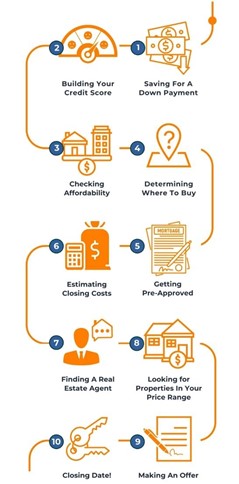Tips For Buying Your First Home

0%
Buying a home in Canada is a stressful and challenging decision. This article will serve as a guide to aid you in buying your first home in Canada.
One of the big decisions, if not the biggest decision, is to proceed and buy your first own house in Canada. This is a very stressful and challenging decision with the big investment and responsibility attached to it. Obviously, the majority of newcomers will be looking to rent a house or an apartment as an easier approach in securing a place to live. While some newcomers will be thinking about buying a new home in the first months after arriving, others may start considering this option after some years of their stay in Canada. In all cases, this article aims to provide a brief guide to aid you in the various steps you need to take in the process of buying your home In Canada along with legal and financial requirements and tips.
Before you Decide on Buying a Home
It is important that you have a clear picture on what is expected in terms of home buying process. Before you proceed with the process, there are three points you have to consider:
• Carry out a comparison between house buying and renting to decide what is more convenient
• Be realistic about the responsibility you are going in and the emotional rollercoaster associated with it
• Consider the economic perspective in terms of your budget, costs, and savings
Types of Houses to Own
Obviously, the first major decision that you need to make in the home buying process is to choose what type of housing you are considering or aiming for. Not all types of homes are the same, and each type has its own specifications along with a different price level. The housing options are as follows:
1. Condo/Condominium: A condo is a unit or an apartment within a larger building. Thus, you will share the building with multiple other neighbours, but you will be responsible for your own unit or apartment. In busy city centers, condos are often the best options available on the market.
2. Single/Detached: A single-detached home is a house located on its own property that shares no walls with other neighbouring properties. This is the most expensive option in house buying in Canada as you will own and be responsible for the land and the building.
3. Semi-Detached: A semi-detached home is similar to a detached home with its own land and entrance but shares a wall with a neighbouring home.
4. Townhouse: This is a home that is attached to other homes on both sides. This is a typical type of home in the majority of big cities in Canada.
5. Duplex/Triplex: A duplex or triplex is a single building made of multiple and separate units. In the majority of the cases, the owner will be living in one or two units, while renting out the other units to help in reducing the running costs of the building. It is also convenient for a family residence with multiple families.
Depending on your budget, location and preferences, choosing one of the five options above will have a direct impact on the legal and financial responsibilities.
Home Buying Steps
The figure below highlights the ten major steps you will go through in the process of buying a home in Canada, from allocating a budget until the closing date.
1. Saving for a Down Payment: A down payment is the money to be paid upfront in the purchase of a home. In Ontario, you should have at least a 5% down payment for home purchase prices under $500,000, where the down payment is 20% for houses of a price over $1,000,000. If this is the first home you are buying, the federal and provincial governments have set up programs to help in this regard including The Home Buyers Plan, The First Time Home Buyer Incentive, and The Provincial and Municipal Land Transfer Tax rebates.
2. Credit Score & Stable Income: Your credit score is one of the major factors that lenders use in evaluating your creditworthiness. Building your credit score is crucial for obtaining a mortgage for your home purchase. To meet the requirements of credit score for obtaining an insured mortgage loan, your score needs to be at least 600.

3. Checking your Affordability: Housing affordability depends on a number of factors, including your income, monthly expenses and the down payment amount.
4. Determining Where to Buy: The associated costs of buying a home in Canada depend very much on the location of the home and the neighbourhood. In buying a house, you shall also consider major factors including commute time, public transit, neighbourhood amenities, safety and school rankings.
5. Closing Costs: An estimate of the closing costs when buying a house in Ontario tends to be between 3 and 5% of the purchase price, majoring covering Land Transfer Tax, and Lawyer & Legal Fees.
6. Mortgage Pre-approval: The next step is getting a mortgage pre-approval from the bank. This allows locking an interest rate for up to 120 days, keeping in mind that a lower interest rate means lower monthly payments.
7. Real Estate: it is recommended as a new buyer to get in touch with multiple real estate agents to help find the home that suits you the best.
8. Look for Properties: Considering your affordability and financial situation, you shall start looking for houses that fit your needs and specifications. Consider using a site like realtor.ca.
9. Make an Offer: As you find the home you wish to buy, it is time to make an offer with the help of your real estate agent who can aid in the offer details, including price and conditions.
10. Closing Date: At this stage, you finalize the purchase of the house by paying the closing costs, and the real estate agent will then deliver the keys of your new home to you.
Tags: home, mortgage, money, house-hunting, real estate, offer, payment, interest rate, buy
RELATED ARTICLES
| M | T | W | T | F | S | S |
|---|---|---|---|---|---|---|
| 1 | 2 | 3 | 4 | 5 | 6 | 7 |
| 8 | 9 | 10 | 11 | 12 | 13 | 14 |
| 15 | 16 | 17 | 18 | 19 | 20 | 21 |
| 22 | 23 | 24 | 25 | 26 | 27 | 28 |
| 29 | 30 | 31 | ||||
Recent Posts
- Local Immigration Partnership Renfrew and Lanark Counties launch online survey
- CULTURE CONNECT: Local Immigration Partnership and United Way East Ontario secure funding for New Horizons Program
- Pathways – Immigration to Canada
- Almonte resident George Yaremchuk presented with Culture Connector Award
- Inspiring Journey: How an international student from India’s experience in Pembroke is shaping her life and career





Recent Comments